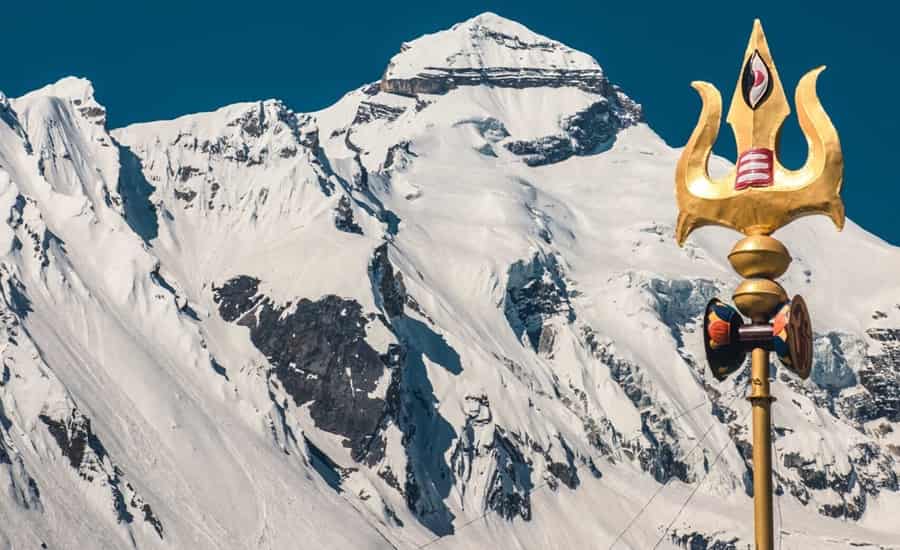Adi Kailash, lovingly called Chhota Kailash, was neither just a mountain of rock and snow but a spiritual realm, imbued with the mystical narratives of its wonderful history.
According to the legend, Adi Kailash was home for Lord Shiva himself. People from far and near set off on the holy pilgrimage to this sanctified mountain in search of peace, direction, and the divine touch.

Mythological reference of Adi Kailash
The Adi Kailash is highly revered in ancient mythology. Despite their distant locations, Mount Kailash of Tibet and Uttarakhand’s Adi Kailash share an eternal bond.
The similarity between the two is so jaw-dropping that Adi Kailash is nicknamed the “Little Kailash” by pilgrims as well as spiritual seekers.
Adi Kailash wasn’t just a place to visit; it became a passageway to the past, with myths and legends mingling with the present.
Mythological Importance of Adi Kailash
It is believed that Adi Kailash is the permanent dwelling of Lord Shiva where he answers the pleas and supplications of his disciples. The faith forms the very basis of the Adi Kailash Yatra, the holy pilgrimage visited by millions seeking personal enlightenment, satisfaction of wishes and inner transformation.
The trip to Adi Kailash is viewed as an important religious walk, with devotees from different countries coming to India to obtain shelter, guidance, and the divine blessings of Lord Shiva.
It is a journey that transcends from the material world as it develops into a profound spiritual quest that allows people to explore the inner world of their devotion and faith.
Adi Kailash, affectionately known as Chhota Kailash, was not merely a peak of rock and snow; it was a sanctuary of spirituality, steeped in rich history and mythical significance
Legend has it that Adi Kailash was the very abode of Lord Shiva himself. Pilgrims from far and wide embarked on a sacred journey to this hallowed mountain, seeking solace, guidance, and the touch of the divine.
Connection to Kailash Parvat
Adi Kailash is believed to be intimately connected with the world famous Mount Kailash in Tibet. The similarity between the two mountains is so remarkable; therefore, Adi Kailash is called Little Kailash. This holy connection gives a good alternative for those who cannot go on the journey to Mount Kailash in Tibet.
Mount Kailash, which is simultaneously venerated by Hindus, Buddhists, and Jains, is regarded as one of the most sacred mountains on Earth.
Adi Kailash serves as a spiritual haven meeting with the spiritual features comparable to Mount Kailash, a holy place where believers can connect with the divine power of the sacred Kailash.
Tales from the Mahabharata
The holy mountain of Adi Kailash commands prominence in the ancient Indian epic of Mahabharata. As the epic states, the five Pandava brothers (Yudhishthira, Bhīma and Arjuna, and Nakula along with their beloved wife Draupadi) departed for a sacred pilgrimage.
Their way led them to Adi Kailash, a place they supposed would purify their souls and give them a foundation for the impending triumph of the Kurukshetra battle.
The link to the Mahabharata gives the Adi Kailash Yatra depth and historical significance.
Each pilgrim who still undertakes the journey today is spiritually connected to the efforts of the Pandavas, and this stresses the transformative nature of the pilgrimage.
Connection to Ravana
Adi Kailash and Ravana are tightly bound by the mythology of Hinduism which is represented in the Ramayana epic. Ravana, the fearful demon king, not only was a powerful enemy but also became a great devotee of Lord Shiva during his entire life.
The myth starts with Ravana conducting hard penance at Adi Kailash to win unequaled strength and authority. Lord Shiva, pleased by Ravana’s undeterred devotion, blessed him with the powers that only existed in the vicinity of heaven.
Nevertheless, Ravana’s tragic end was due to his misuse of these powers that stand as a lesson to the wise on the need to be responsible with power and the dangers that can come with pride. The saga of Ravana is a moral compass for those who have embarked on the spiritual journey, it is a lesson that one should learn from the story of Ravana.
Sage Parvati’s Vratha at Adi Kailash
Lady Parvati’s fast at Adi Kailash is a couple of the touching chapters of Hindu mythology which narrate her unwavering perseverance and persistence in staying constantly close to her better half, Lord Shiva. Sage Parvati undertook tough penances at Adi Kailash, which involved meditation, prayers, and self-restraint as its spiritual disciplines.
The compassionate Lord Shiva, touched by the devotion of Maitryee, granted her wish, declaring Adi Kailash as his abode.
The story is an allegory for the power of dedication that can transform a person, and it is also a lesson for pilgrims to start and finish the Adi Kailash Yatra with humility and deep trust in God.
As per several mythical tales, the presence of Lord Shiva in Adi Kailash reflects his strong and unbreakable bond with Mata Parvati, and commitment towards granting the pleas of his devotees.
Those with pure hearts and a whole-hearted devotion can go to Adi Kailash to ask for the favors of Lord Shiva, after which their wishes would be granted.
Other-Worldly Philosophies in the Mahabharata and the Ramayana
The allusions to the Mahabharata and Ramayana that are suggested in the framework of Adi Kailash give spiritual instruction in deep meanings.
The Mahabharata portrays the effect of pilgrimage phenomenon on the Pandavas and their eventual victory in the battle of Kurukshetra. The Pandavas’ journey to Adi Kailash helped in purging their soils. A theme of this work is that a sacred pilgrimage acts as a medium for cleansing of the human spirit.
While Ramayana’s tale of Ravana at Adi Kailash is an instructive story about power use and the perils of disobedience, the Ramayana’s account of Ravana at Adi Kailash is an instructive tale about the responsible use of power and the consequences of vanity.
Pilgrims are to take a lesson from those epic stories by being able to discover truth in the past and apply it to their spiritual enhancement during the Adi Kailash Yatra journey.
Historical importance of Adi Kailash Mountain
Adi Kailash is a pilgrimage destination which has stood as an ancient site of devotion. Its origins probably go back to the reign of Hinduism when pilgrimage was symbolized as a pious deed.
The linkage between pilgrimage and historical significance is very obvious, as numerous pilgrims have traversed the long distance to find heavenly rewards, spiritual enlightenment, and a deeper relationship with the divine.
During centuries pilgrims coming from all parts of India and beyond would face tough climbs, physical suffering, and elements of nature in search of spiritual connection at Adi Kailash.
The historical significance is not only tied to the place, but also includes a long list of stories, legends, and myths related to it.
In contemporary times pilgrims and pilgrims alike still come to Adi Kailash to be electrified and to be inspired by its historical importance as a sacred site and the spiritual energy which emanates from it.
Continuity of Spirituality
Travelers in Adi Kailash realize that spirituality is eternal and this search for the divine is forever. Spiritual meaning gives a feeling of oneness and connection of modern pilgrims to the millions of souls who have found comfort, enlightenment, or transformation at this holy place that they have visited throughout centuries.
The Adi Kailash Yatra stands as a symbol of the persevering dedication of mankind and the unchanging search for spiritual wisdom.
Pilgrims are not merely observers of a historical tradition, but they become the links that keep the chain unbroken; thus, they get to be connected to generations of seekers whose common quest has been to walk the same sacred paths and reach the higher spiritual reality.
Conclusion
Pilgrims coming to India from all corners of the earth are quite literally pulled magnetically towards Mount Kailash. This is the place which is not just a shelter and a guide; it is the place where the blessings of Lord Shiva are sought after.
Adi Kailash, with its deep historical and mythological texture, becomes more than a simple Himalayan peak. It is a paradise for the human soul to regain touch with the eternal core of the human soul in pursuit of Deity.









 Call
Call WhatsApp
WhatsApp Enquiry
Enquiry